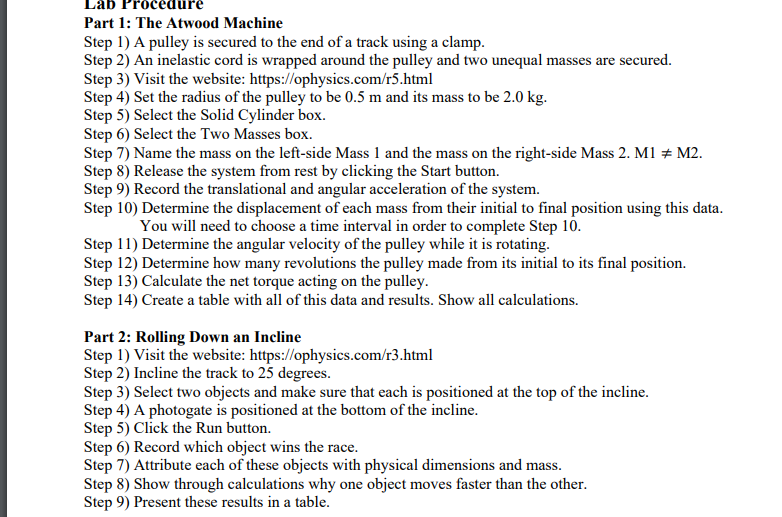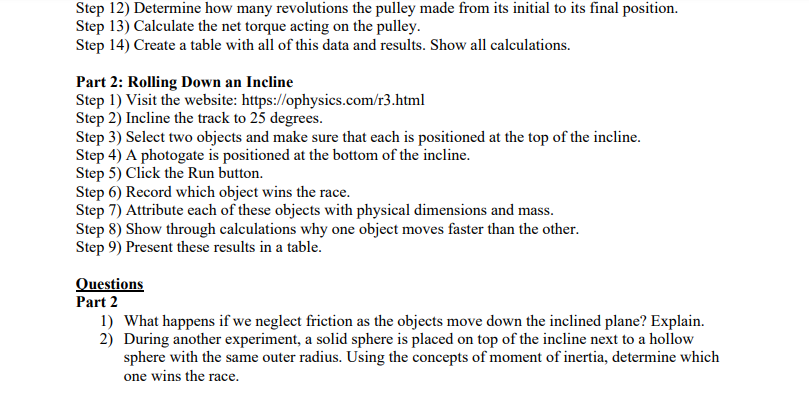Step 4) Set the radius of the pulley to be 0.5 m and its mass to be 2.0 kg. Step 5) Select the Solid Cylinder box. Step 6) Select the Two Masses box. Step 7) Name the mass on the left-side Mass 1 and the mass on the right-side Mass 2. M1 # M2. Step 8) Release the system from rest by clicking the Start button. Step 9) Record the translational and angular acceleration of the system. Step 10) Determine the displacement of each mass from their initial to final position using this data. You will need to choose a time interval in order to complete Step 10. Step 11) Determine the angular velocity of the pulley while it is rotating. Step 12) Determine how many revolutions the pulley made from its initial to its final position. Step 13) Calculate the net torque acting on the pulley. Step 14) Create a table with all of this data and results. Show all calculations. Part 2: Rolling Down an Incline Step 1) Visit the website: https://ophysics.com/r3.html Step 2) Incline the track to 25 degrees. Step 3) Select two objects and make sure that each is positioned at the top of the incline. Step 4) A photogate is positioned at the bottom of the incline. Step 5) Click the Run button. Step 6) Record which object wins the race. Step 7) Attribute each of these objects with physical dimensions and mass. Step 8) Show through calculations why one object moves faster than the other. Step 9) Present these results in a table.
Step 4) Set the radius of the pulley to be 0.5 m and its mass to be 2.0 kg. Step 5) Select the Solid Cylinder box. Step 6) Select the Two Masses box. Step 7) Name the mass on the left-side Mass 1 and the mass on the right-side Mass 2. M1 # M2. Step 8) Release the system from rest by clicking the Start button. Step 9) Record the translational and angular acceleration of the system. Step 10) Determine the displacement of each mass from their initial to final position using this data. You will need to choose a time interval in order to complete Step 10. Step 11) Determine the angular velocity of the pulley while it is rotating. Step 12) Determine how many revolutions the pulley made from its initial to its final position. Step 13) Calculate the net torque acting on the pulley. Step 14) Create a table with all of this data and results. Show all calculations. Part 2: Rolling Down an Incline Step 1) Visit the website: https://ophysics.com/r3.html Step 2) Incline the track to 25 degrees. Step 3) Select two objects and make sure that each is positioned at the top of the incline. Step 4) A photogate is positioned at the bottom of the incline. Step 5) Click the Run button. Step 6) Record which object wins the race. Step 7) Attribute each of these objects with physical dimensions and mass. Step 8) Show through calculations why one object moves faster than the other. Step 9) Present these results in a table.
University Physics Volume 1
18th Edition
ISBN:9781938168277
Author:William Moebs, Samuel J. Ling, Jeff Sanny
Publisher:William Moebs, Samuel J. Ling, Jeff Sanny
Chapter12: Static Equilibrium And Elasticity
Section: Chapter Questions
Problem 81CP: The pole shown below is at a 90.0 bend in a power line and is therefore subjected to more shear...
Related questions
Question
100%
show work

Transcribed Image Text:Lab
Part 1: The Atwood Machine
Step 1) A pulley is secured to the end of a track using a clamp.
Step 2) An inelastic cord is wrapped around the pulley and two unequal masses are secured.
Step 3) Visit the website: https://ophysics.com/r5.html
Step 4) Set the radius of the pulley to be 0.5 m and its mass to be 2.0 kg.
Step 5) Select the Solid Cylinder box.
Step 6) Select the Two Masses box.
Step 7) Name the mass on the left-side Mass 1 and the mass on the right-side Mass 2. M1 + M2.
Step 8) Release the system from rest by clicking the Start button.
Step 9) Record the translational and angular acceleration of the system.
Step 10) Determine the displacement of each mass from their initial to final position using this data.
You will need to choose a time interval in order to complete Step 10.
Step 11) Determine the angular velocity of the pulley while it is rotating.
Step 12) Determine how many revolutions the pulley made from its initial to its final position.
Step 13) Calculate the net torque acting on the pulley.
Step 14) Create a table with all of this data and results. Show all calculations.
Part 2: Rolling Down an Incline
Step 1) Visit the website: https://ophysics.com/r3.html
Step 2) Incline the track to 25 degrees.
Step 3) Select two objects and make sure that each is positioned at the top of the incline.
Step 4) A photogate is positioned at the bottom of the incline.
Step 5) Click the Run button.
Step 6) Record which object wins the race.
Step 7) Attribute each of these objects with physical dimensions and mass.
Step 8) Show through calculations why one object moves faster than the other.
Step 9) Present these results in a table.

Transcribed Image Text:Step 12) Determine how many revolutions the pulley made from its initial to its final position.
Step 13) Calculate the net torque acting on the pulley.
Step 14) Create a table with all of this data and results. Show all calculations.
Part 2: Rolling Down an Incline
Step 1) Visit the website: https://ophysics.com/r3.html
Step 2) Incline the track to 25 degrees.
Step 3) Select two objects and make sure that each is positioned at the top of the incline.
Step 4) A photogate is positioned at the bottom of the incline.
Step 5) Click the Run button.
Step 6) Record which object wins the race.
Step 7) Attribute each of these objects with physical dimensions and mass.
Step 8) Show through calculations why one object moves faster than the other.
Step 9) Present these results in a table.
Questions
Part 2
1) What happens if we neglect friction as the objects move down the inclined plane? Explain.
During another experiment, a solid sphere is placed on top of the incline next to a hollow
sphere with the same outer radius. Using the concepts of moment of inertia, determine which
one wins the race.
Expert Solution
This question has been solved!
Explore an expertly crafted, step-by-step solution for a thorough understanding of key concepts.
This is a popular solution!
Trending now
This is a popular solution!
Step by step
Solved in 2 steps with 2 images

Knowledge Booster
Learn more about
Need a deep-dive on the concept behind this application? Look no further. Learn more about this topic, physics and related others by exploring similar questions and additional content below.Recommended textbooks for you

University Physics Volume 1
Physics
ISBN:
9781938168277
Author:
William Moebs, Samuel J. Ling, Jeff Sanny
Publisher:
OpenStax - Rice University

College Physics
Physics
ISBN:
9781938168000
Author:
Paul Peter Urone, Roger Hinrichs
Publisher:
OpenStax College

Glencoe Physics: Principles and Problems, Student…
Physics
ISBN:
9780078807213
Author:
Paul W. Zitzewitz
Publisher:
Glencoe/McGraw-Hill

University Physics Volume 1
Physics
ISBN:
9781938168277
Author:
William Moebs, Samuel J. Ling, Jeff Sanny
Publisher:
OpenStax - Rice University

College Physics
Physics
ISBN:
9781938168000
Author:
Paul Peter Urone, Roger Hinrichs
Publisher:
OpenStax College

Glencoe Physics: Principles and Problems, Student…
Physics
ISBN:
9780078807213
Author:
Paul W. Zitzewitz
Publisher:
Glencoe/McGraw-Hill